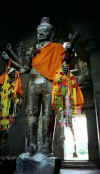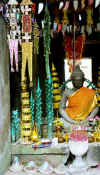Glory Days of the Khmer
Friday 3 December – Monday 6 December
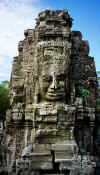 By
the time we had arrived back in Bangkok after our tour of Thailand and had
finally started making travel plans to get ourselves to India by Christmas,
December was already upon us. We
suddenly realised we would have to start making trade-offs with respect to the
amount of time we could spend in both Cambodia and Burma en route to Delhi.
Having originally envisaged spending a week or so in Cambodia, first in
the capital Phnom Penh then exploring the remains of the magnificent temples of
the Khmer empire at Angkor, we were now only able to squeeze in a mere three
By
the time we had arrived back in Bangkok after our tour of Thailand and had
finally started making travel plans to get ourselves to India by Christmas,
December was already upon us. We
suddenly realised we would have to start making trade-offs with respect to the
amount of time we could spend in both Cambodia and Burma en route to Delhi.
Having originally envisaged spending a week or so in Cambodia, first in
the capital Phnom Penh then exploring the remains of the magnificent temples of
the Khmer empire at Angkor, we were now only able to squeeze in a mere three 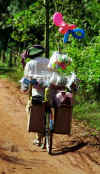 days.
Given our time constraints, we opted to head directly for Siem Reap,
gateway to Angkor, and spent a weekend trying to cram in as much temple gazing
as we could.
days.
Given our time constraints, we opted to head directly for Siem Reap,
gateway to Angkor, and spent a weekend trying to cram in as much temple gazing
as we could.
Flying in, our first impression
of Cambodia had been of a flat countryside of rice paddies and patches of open
water. We discovered whilst driving to our hotel that the road
system left a lot to be desired -- dirt roads studded liberally with potholes
(somewhat reminiscent of the roads in Mongolia).
And along the roadside, school children, bicyclists and men in uniform
hobbling on crutches, the limp trouser leg or shirtsleeve attesting to the
horrible reality of landmines. These are admittedly superficial
observations: we had not come to explore Cambodia: Angkor would suffice
for this trip.
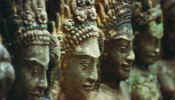 Scattered
over something like 100 square miles of landscape which somehow manages to be
simultaneously lush and dusty, the temples of Angkor comprise most of what
remains of the great Khmer civilisation. Under construction
Scattered
over something like 100 square miles of landscape which somehow manages to be
simultaneously lush and dusty, the temples of Angkor comprise most of what
remains of the great Khmer civilisation. Under construction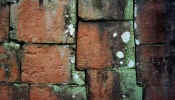 continuously from the 8th to the 14th centuries, the temples were mainly
dedicated to the Hindu gods Shiva and Vishnu, and also to the Buddha.
Since they were destined as dwelling places for the immortal gods, they were
built of durable materials (brick, laterite and stone) using the most exquisite
craftsmanship. As it would have been sacrilege to construct secular
buildings (e.g. palaces and houses) with the same materials and care, these have
not survived.
continuously from the 8th to the 14th centuries, the temples were mainly
dedicated to the Hindu gods Shiva and Vishnu, and also to the Buddha.
Since they were destined as dwelling places for the immortal gods, they were
built of durable materials (brick, laterite and stone) using the most exquisite
craftsmanship. As it would have been sacrilege to construct secular
buildings (e.g. palaces and houses) with the same materials and care, these have
not survived.
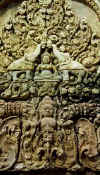
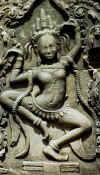
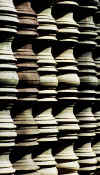
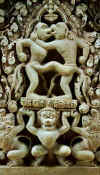
 Once
we had arranged the logistics, it was time to get down to business. We
Once
we had arranged the logistics, it was time to get down to business. We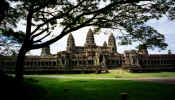 were out before dawn to catch the sunrise at the spiritual center of Angkor, the
temple of Angkor Wat. Not only the world's largest religious monument,
Angkor is considered by more than a few connoisseurs to be the most sublime work
of architecture on the planet. While we don't presume to judge that, we
were mightily impressed.
were out before dawn to catch the sunrise at the spiritual center of Angkor, the
temple of Angkor Wat. Not only the world's largest religious monument,
Angkor is considered by more than a few connoisseurs to be the most sublime work
of architecture on the planet. While we don't presume to judge that, we
were mightily impressed.
 Angkor
Wat was built in the 12th century, at the height of Khmer power.
Simultaneously a temple complex and a capitol, it is a completely realized
microcosm of the
Angkor
Wat was built in the 12th century, at the height of Khmer power.
Simultaneously a temple complex and a capitol, it is a completely realized
microcosm of the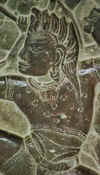 Hindu universe, culminating in the five peaks of Mount Meru. Its grandeur
is magnified by the quality and abundance of its decorative detail; the Khmers
could carve stone with the best of them.
Hindu universe, culminating in the five peaks of Mount Meru. Its grandeur
is magnified by the quality and abundance of its decorative detail; the Khmers
could carve stone with the best of them.
Over the ensuing several days,
we rushed from temple to temple, experiencing something new around every
corner. From the haunting faces of the Buddhist Bayon to the
doll-house-like jewel of Banteay Srei, from the overgrown "lost ruins"
of Ta Prohm to the magnificence of Angkor Wat, we were totally captivated by the
evident piety, ingenuity, sophistication and wealth of the ancient Khmer.
There is nothing else like Angkor on this earth.
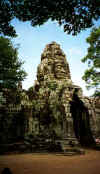
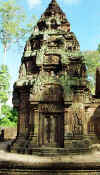
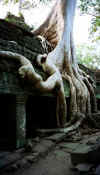
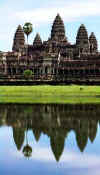
How bitterly ironic that modern
Cambodia was a shambles, its people limping around on crutches, scarcely
able to feed themselves. And yet, as the abundance of offerings and monks
made clear, their spiritual faith was unflagging. Was that grounds for
optimism, or pity? We headed on to Burma, awestruck and saddened.
